Chi Harold Liu
CoMBO: Conflict Mitigation via Branched Optimization for Class Incremental Segmentation
Apr 05, 2025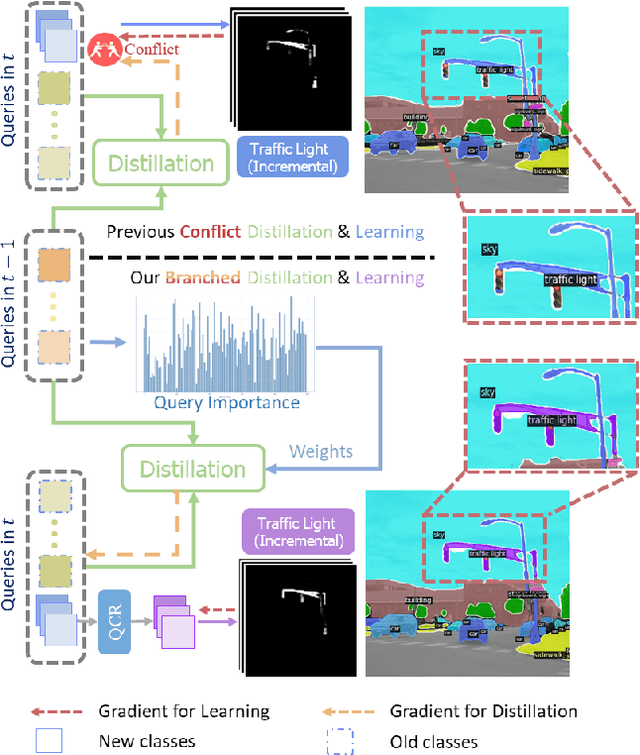

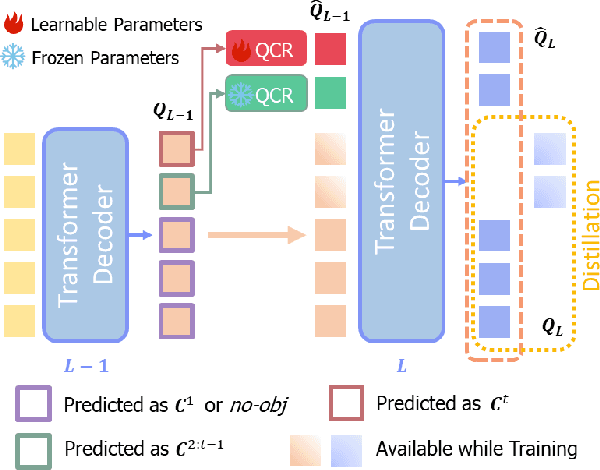

Abstract:Effective Class Incremental Segmentation (CIS) requires simultaneously mitigating catastrophic forgetting and ensuring sufficient plasticity to integrate new classes. The inherent conflict above often leads to a back-and-forth, which turns the objective into finding the balance between the performance of previous~(old) and incremental~(new) classes. To address this conflict, we introduce a novel approach, Conflict Mitigation via Branched Optimization~(CoMBO). Within this approach, we present the Query Conflict Reduction module, designed to explicitly refine queries for new classes through lightweight, class-specific adapters. This module provides an additional branch for the acquisition of new classes while preserving the original queries for distillation. Moreover, we develop two strategies to further mitigate the conflict following the branched structure, \textit{i.e.}, the Half-Learning Half-Distillation~(HDHL) over classification probabilities, and the Importance-Based Knowledge Distillation~(IKD) over query features. HDHL selectively engages in learning for classification probabilities of queries that match the ground truth of new classes, while aligning unmatched ones to the corresponding old probabilities, thus ensuring retention of old knowledge while absorbing new classes via learning negative samples. Meanwhile, IKD assesses the importance of queries based on their matching degree to old classes, prioritizing the distillation of important features and allowing less critical features to evolve. Extensive experiments in Class Incremental Panoptic and Semantic Segmentation settings have demonstrated the superior performance of CoMBO. Project page: https://guangyu-ryan.github.io/CoMBO.
HACTS: a Human-As-Copilot Teleoperation System for Robot Learning
Mar 31, 2025Abstract:Teleoperation is essential for autonomous robot learning, especially in manipulation tasks that require human demonstrations or corrections. However, most existing systems only offer unilateral robot control and lack the ability to synchronize the robot's status with the teleoperation hardware, preventing real-time, flexible intervention. In this work, we introduce HACTS (Human-As-Copilot Teleoperation System), a novel system that establishes bilateral, real-time joint synchronization between a robot arm and teleoperation hardware. This simple yet effective feedback mechanism, akin to a steering wheel in autonomous vehicles, enables the human copilot to intervene seamlessly while collecting action-correction data for future learning. Implemented using 3D-printed components and low-cost, off-the-shelf motors, HACTS is both accessible and scalable. Our experiments show that HACTS significantly enhances performance in imitation learning (IL) and reinforcement learning (RL) tasks, boosting IL recovery capabilities and data efficiency, and facilitating human-in-the-loop RL. HACTS paves the way for more effective and interactive human-robot collaboration and data-collection, advancing the capabilities of robot manipulation.
ACL-QL: Adaptive Conservative Level in Q-Learning for Offline Reinforcement Learning
Dec 22, 2024Abstract:Offline Reinforcement Learning (RL), which operates solely on static datasets without further interactions with the environment, provides an appealing alternative to learning a safe and promising control policy. The prevailing methods typically learn a conservative policy to mitigate the problem of Q-value overestimation, but it is prone to overdo it, leading to an overly conservative policy. Moreover, they optimize all samples equally with fixed constraints, lacking the nuanced ability to control conservative levels in a fine-grained manner. Consequently, this limitation results in a performance decline. To address the above two challenges in a united way, we propose a framework, Adaptive Conservative Level in Q-Learning (ACL-QL), which limits the Q-values in a mild range and enables adaptive control on the conservative level over each state-action pair, i.e., lifting the Q-values more for good transitions and less for bad transitions. We theoretically analyze the conditions under which the conservative level of the learned Q-function can be limited in a mild range and how to optimize each transition adaptively. Motivated by the theoretical analysis, we propose a novel algorithm, ACL-QL, which uses two learnable adaptive weight functions to control the conservative level over each transition. Subsequently, we design a monotonicity loss and surrogate losses to train the adaptive weight functions, Q-function, and policy network alternatively. We evaluate ACL-QL on the commonly used D4RL benchmark and conduct extensive ablation studies to illustrate the effectiveness and state-of-the-art performance compared to existing offline DRL baselines.
Bridge the Points: Graph-based Few-shot Segment Anything Semantically
Oct 09, 2024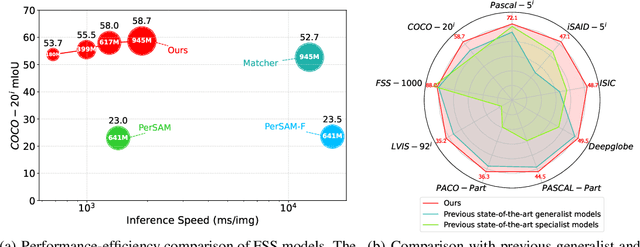
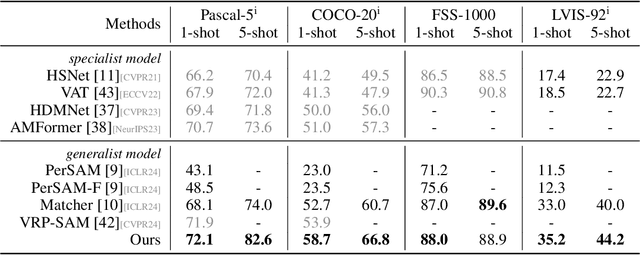
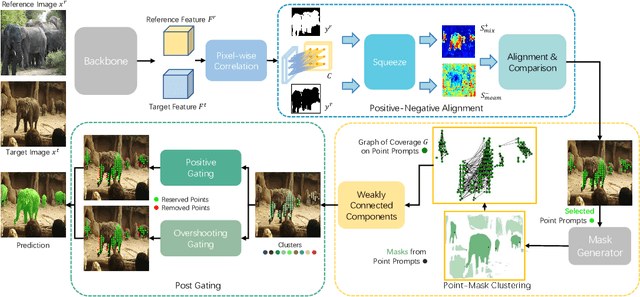
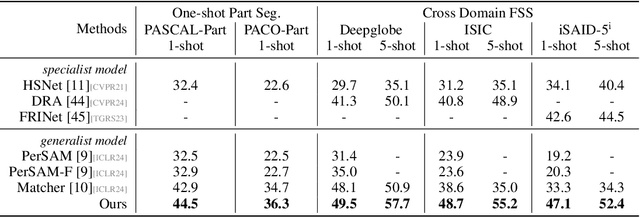
Abstract:The recent advancements in large-scale pre-training techniques have significantly enhanced the capabilities of vision foundation models, notably the Segment Anything Model (SAM), which can generate precise masks based on point and box prompts. Recent studies extend SAM to Few-shot Semantic Segmentation (FSS), focusing on prompt generation for SAM-based automatic semantic segmentation. However, these methods struggle with selecting suitable prompts, require specific hyperparameter settings for different scenarios, and experience prolonged one-shot inference times due to the overuse of SAM, resulting in low efficiency and limited automation ability. To address these issues, we propose a simple yet effective approach based on graph analysis. In particular, a Positive-Negative Alignment module dynamically selects the point prompts for generating masks, especially uncovering the potential of the background context as the negative reference. Another subsequent Point-Mask Clustering module aligns the granularity of masks and selected points as a directed graph, based on mask coverage over points. These points are then aggregated by decomposing the weakly connected components of the directed graph in an efficient manner, constructing distinct natural clusters. Finally, the positive and overshooting gating, benefiting from graph-based granularity alignment, aggregate high-confident masks and filter out the false-positive masks for final prediction, reducing the usage of additional hyperparameters and redundant mask generation. Extensive experimental analysis across standard FSS, One-shot Part Segmentation, and Cross Domain FSS datasets validate the effectiveness and efficiency of the proposed approach, surpassing state-of-the-art generalist models with a mIoU of 58.7% on COCO-20i and 35.2% on LVIS-92i. The code is available in https://andyzaq.github.io/GF-SAM/.
Benchmarking the Text-to-SQL Capability of Large Language Models: A Comprehensive Evaluation
Mar 06, 2024



Abstract:Large Language Models (LLMs) have emerged as a powerful tool in advancing the Text-to-SQL task, significantly outperforming traditional methods. Nevertheless, as a nascent research field, there is still no consensus on the optimal prompt templates and design frameworks. Additionally, existing benchmarks inadequately explore the performance of LLMs across the various sub-tasks of the Text-to-SQL process, which hinders the assessment of LLMs' cognitive capabilities and the optimization of LLM-based solutions. To address the aforementioned issues, we firstly construct a new dataset designed to mitigate the risk of overfitting in LLMs. Then we formulate five evaluation tasks to comprehensively assess the performance of diverse methods across various LLMs throughout the Text-to-SQL process.Our study highlights the performance disparities among LLMs and proposes optimal in-context learning solutions tailored to each task. These findings offer valuable insights for enhancing the development of LLM-based Text-to-SQL systems.
An Efficient Generalizable Framework for Visuomotor Policies via Control-aware Augmentation and Privilege-guided Distillation
Jan 17, 2024Abstract:Visuomotor policies, which learn control mechanisms directly from high-dimensional visual observations, confront challenges in adapting to new environments with intricate visual variations. Data augmentation emerges as a promising method for bridging these generalization gaps by enriching data variety. However, straightforwardly augmenting the entire observation shall impose excessive burdens on policy learning and may even result in performance degradation. In this paper, we propose to improve the generalization ability of visuomotor policies as well as preserve training stability from two aspects: 1) We learn a control-aware mask through a self-supervised reconstruction task with three auxiliary losses and then apply strong augmentation only to those control-irrelevant regions based on the mask to reduce the generalization gaps. 2) To address training instability issues prevalent in visual reinforcement learning (RL), we distill the knowledge from a pretrained RL expert processing low-level environment states, to the student visuomotor policy. The policy is subsequently deployed to unseen environments without any further finetuning. We conducted comparison and ablation studies across various benchmarks: the DMControl Generalization Benchmark (DMC-GB), the enhanced Robot Manipulation Distraction Benchmark (RMDB), and a specialized long-horizontal drawer-opening robotic task. The extensive experimental results well demonstrate the effectiveness of our method, e.g., showing a 17\% improvement over previous methods in the video-hard setting of DMC-GB.
HiBid: A Cross-Channel Constrained Bidding System with Budget Allocation by Hierarchical Offline Deep Reinforcement Learning
Dec 29, 2023



Abstract:Online display advertising platforms service numerous advertisers by providing real-time bidding (RTB) for the scale of billions of ad requests every day. The bidding strategy handles ad requests cross multiple channels to maximize the number of clicks under the set financial constraints, i.e., total budget and cost-per-click (CPC), etc. Different from existing works mainly focusing on single channel bidding, we explicitly consider cross-channel constrained bidding with budget allocation. Specifically, we propose a hierarchical offline deep reinforcement learning (DRL) framework called ``HiBid'', consisted of a high-level planner equipped with auxiliary loss for non-competitive budget allocation, and a data augmentation enhanced low-level executor for adaptive bidding strategy in response to allocated budgets. Additionally, a CPC-guided action selection mechanism is introduced to satisfy the cross-channel CPC constraint. Through extensive experiments on both the large-scale log data and online A/B testing, we confirm that HiBid outperforms six baselines in terms of the number of clicks, CPC satisfactory ratio, and return-on-investment (ROI). We also deploy HiBid on Meituan advertising platform to already service tens of thousands of advertisers every day.
Annotator: A Generic Active Learning Baseline for LiDAR Semantic Segmentation
Oct 31, 2023



Abstract:Active learning, a label-efficient paradigm, empowers models to interactively query an oracle for labeling new data. In the realm of LiDAR semantic segmentation, the challenges stem from the sheer volume of point clouds, rendering annotation labor-intensive and cost-prohibitive. This paper presents Annotator, a general and efficient active learning baseline, in which a voxel-centric online selection strategy is tailored to efficiently probe and annotate the salient and exemplar voxel girds within each LiDAR scan, even under distribution shift. Concretely, we first execute an in-depth analysis of several common selection strategies such as Random, Entropy, Margin, and then develop voxel confusion degree (VCD) to exploit the local topology relations and structures of point clouds. Annotator excels in diverse settings, with a particular focus on active learning (AL), active source-free domain adaptation (ASFDA), and active domain adaptation (ADA). It consistently delivers exceptional performance across LiDAR semantic segmentation benchmarks, spanning both simulation-to-real and real-to-real scenarios. Surprisingly, Annotator exhibits remarkable efficiency, requiring significantly fewer annotations, e.g., just labeling five voxels per scan in the SynLiDAR-to-SemanticKITTI task. This results in impressive performance, achieving 87.8% fully-supervised performance under AL, 88.5% under ASFDA, and 94.4% under ADA. We envision that Annotator will offer a simple, general, and efficient solution for label-efficient 3D applications. Project page: https://binhuixie.github.io/annotator-web
CoinSeg: Contrast Inter- and Intra- Class Representations for Incremental Segmentation
Oct 10, 2023



Abstract:Class incremental semantic segmentation aims to strike a balance between the model's stability and plasticity by maintaining old knowledge while adapting to new concepts. However, most state-of-the-art methods use the freeze strategy for stability, which compromises the model's plasticity.In contrast, releasing parameter training for plasticity could lead to the best performance for all categories, but this requires discriminative feature representation.Therefore, we prioritize the model's plasticity and propose the Contrast inter- and intra-class representations for Incremental Segmentation (CoinSeg), which pursues discriminative representations for flexible parameter tuning. Inspired by the Gaussian mixture model that samples from a mixture of Gaussian distributions, CoinSeg emphasizes intra-class diversity with multiple contrastive representation centroids. Specifically, we use mask proposals to identify regions with strong objectness that are likely to be diverse instances/centroids of a category. These mask proposals are then used for contrastive representations to reinforce intra-class diversity. Meanwhile, to avoid bias from intra-class diversity, we also apply category-level pseudo-labels to enhance category-level consistency and inter-category diversity. Additionally, CoinSeg ensures the model's stability and alleviates forgetting through a specific flexible tuning strategy. We validate CoinSeg on Pascal VOC 2012 and ADE20K datasets with multiple incremental scenarios and achieve superior results compared to previous state-of-the-art methods, especially in more challenging and realistic long-term scenarios. Code is available at https://github.com/zkzhang98/CoinSeg.
Dirichlet-based Uncertainty Calibration for Active Domain Adaptation
Feb 27, 2023
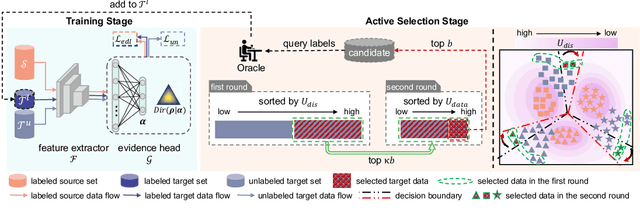


Abstract:Active domain adaptation (DA) aims to maximally boost the model adaptation on a new target domain by actively selecting limited target data to annotate, whereas traditional active learning methods may be less effective since they do not consider the domain shift issue. Despite active DA methods address this by further proposing targetness to measure the representativeness of target domain characteristics, their predictive uncertainty is usually based on the prediction of deterministic models, which can easily be miscalibrated on data with distribution shift. Considering this, we propose a \textit{Dirichlet-based Uncertainty Calibration} (DUC) approach for active DA, which simultaneously achieves the mitigation of miscalibration and the selection of informative target samples. Specifically, we place a Dirichlet prior on the prediction and interpret the prediction as a distribution on the probability simplex, rather than a point estimate like deterministic models. This manner enables us to consider all possible predictions, mitigating the miscalibration of unilateral prediction. Then a two-round selection strategy based on different uncertainty origins is designed to select target samples that are both representative of target domain and conducive to discriminability. Extensive experiments on cross-domain image classification and semantic segmentation validate the superiority of DUC.
 Add to Chrome
Add to Chrome Add to Firefox
Add to Firefox Add to Edge
Add to Edge